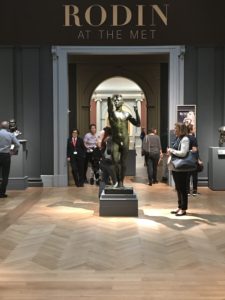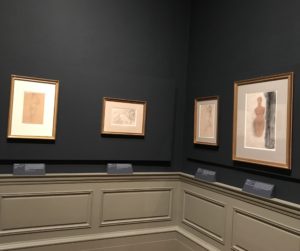“Rodin at the Met”: Upholding a Long-Standing History

The sculptures and drawings of Auguste Rodin, on view in “Rodin at the Met” remind viewers of the beauty in human life and human bodies. The Metropolitan Museum of Art presents this exhibition alongside numerous worldwide exhibitions celebrating Rodin’s legacy and commemorating 100 years since his passing (1840-1917). This exhibition not only serves as a nod to the career of arguably the greatest sculptor to ever live, but it also represents the range of Rodin works the Met possess in their collection. The anniversary of Rodin’s death has sparked a worldwide phenomenon, connected through the hash tag #Rodin100. Many museums and collections are all hosting exhibitions this year to memorialize his career and his contributions to art history which forever changed the potentiality of sculpture.
This special exhibition at the Met features some of his greater known sculptures in addition to his lesser-known drawings, paired with paintings that hang on the walls of the B. Gerald Cantor Sculpture Gallery (gallery 800). Rodin’s sculptures are placed in direct conversation with paintings by artists who were living and working at the same time as Rodin, some of whom he knew. These paintings explore similar thematic ideas as the sculpture nearby. The long hall is divided into subjects that Rodin dealt with through the medium of sculpture. “The Nude,” “Rodin’s Muses,” “The Burghers of Calais” and “The Gates of Hell” are complimented by paintings from Claude Monet, Auguste Renoir, and more.

The sculptures themselves, some small and some larger than life, perhaps conjure up thoughts of the Rodin Museum located in Paris, an exemplary space with quintessential curating. The Met curators for this exhibition deliberately included works of his in multiple mediums such as bronze, terracotta, and marble. The marble works were particularly impactful in the way the light reflected off the smooth surface and the way they offered a contrast to the darker, heavier bronze pieces. The crowd in the B. Gerald Cantor Sculpture Gallery was very responsive to this collection of works and spent time studying them up close. It was noteworthy that those behind this exhibition chose not to contextualize it too much or provide much text at all; they refreshingly let the objects speak for themselves. The focus of the exhibition was truly on the beauty of the figures Rodin created and each emotion or motif calling to viewers to draw out of each pairing.
Visiting this show was humbling in comparison to the chaos outside the walls of the Met and the busyness of life in New York City. This exhibition allowed visitors to temporarily reside in both a physical space and a headspace filled with beautiful bodies, reminding us that we all possess alluring hands, feet, and features and prompting us to see the beauteous in one another as human beings during disheartening political times. Rodin’s works reflect a timelessness that makes them relevant and able to be appreciated in any time or age. Rodin’s art ignites feelings of humility in those engaged and responsive to the work. It would be hard not to see and feel the emotive qualities of his sculptures and drawings.

“Rodin at the Met” speaks to how beloved the Met is as an institution. The Met was capable of these extremely successful acquisitions years ago, granting Rodin a presence in an American museum. The Met was also gifted numerous works from members who cared to support and back the museum. This exhibition was one of the best I have seen in recent months. The worldwide celebration of Rodin’s death reaffirms his importance to art history and his greatness as a sculptor in propelling the evolution of fine art. On view until January 15, 208, I highly recommend a quick trip to the Met for this exhibition.